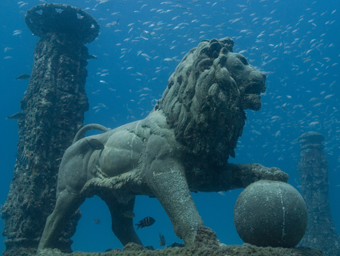Off the coast of Key Biscayne, Florida, a city of the dead is rising.

Neptune Memorial Reef, off the coast of Florida, is an underwater cemetery city that will eventually be able to accommodate more than 100,000 people. The artificial reef attracts tropical fish and scuba divers and is designed to withstand a category 4 hurricane.
Neptune Memorial Reef is an array of concrete structures infused with cremated remains, designed to form an elaborate underwater cemetery that, when complete, will cover 16 acres and be able to accommodate more than 125,000 dead. Reef occupants can choose placement in columns, arches, lion statues, or mounds shaped like creatures of the sea.
“The most popular are the marine placements,” said Stephen Ziadie, the reef’s Chief Operating Officer. “Everyone wants to be a shellfish, starfish, or brain coral.”
ECO-FRIENDLY FUNERALS EXPLAINED
The Neptune Memorial Reef is a project of the Neptune Society, a U.S. company focused on cremation. Neptune is one of a handful of companies crafting innovative underwater burial sites in warm Florida waters.
The Atlanta-based company, Eternal Reefs, combines an individual’s cremated remains with “eco-friendly cast concrete” to form what the company calls “reef balls.” There are reef ball sites off the coast of Fort Meyers and Miami, as well as Ocean City, New Jersey, and Charleston, South Carolina. Loved ones of the deceased gather for a reef casting ceremony and can return to the reef site to dive, fish, or examine the structure from a glass bottom boat.
Great Burial Reef memorials stand about three feet tall and are “molded from 100% natural concrete with a natural additive which accelerates undersea marine growth once it reaches the ocean floor.” Their reefs are in ten locations around Florida, including off the coasts of Venice, Port Canaveral, and West Palm Beach.
The placement of cremated remains in artificial reefs is a recent trend that may be linked to the economic recession and a nationwide increase in cremations, which are often cheaper than traditional full-body burials. Companies all focus on the green aspect of reef burial and the idea that life can beget life. It is a trend that is thoroughly modern, but there are colorful historical precedents, such as the underwater tomb of King Munmu, located in a rocky inlet in the East Sea, off Bonggil Beach, South Korea.
Munmu lived from 661 to 681 A.D. and was the 30th ruler of the Silla Kingdom. He requested to be buried in the East Sea so as to become a dragon and protect Silla from Japanese intruders. Munmu’s remains were buried under a massive granite rock at the bottom of a pool in a cross-shaped channel, although whether his ashes were scattered or placed in an urn is still debated by scholars. “Underwater Tomb of King Munmu is one of the few attractions of Gyeongju where no admission fee is charged and is open all year round 24 hours,” reads one South Korean travel website.
Neptune Memorial Reef has also become a tourist destination; scuba divers come to spot the tropical fish, eels, and turtles that feed among the structures. The reef was originally designed by two friends, an avid fisherman and a man named Kim Brandell, a metal sculptor who fashions the large signature stainless steel globes that stand at the entrance to several of Donald Trump’s towers. The reef’s structures are anchored more than 15 feet into the seafloor and are intended to withstand a Category 4 hurricane. The first pieces were erected two years ago. Standard placement in the reef, such as in an archway or column, costs $2699; placement in a more ornate structure, like a lion, costs $3999. More than 50% of the 1,100 placements already constructed have been filled.
“People generally think it’s a really cool concept, but not everybody wants to be interned in the ocean,” said Ziadie. “But, I’ll tell you; we are seeing a lot of our customers from Florida, but also a lot in the Midwest, who don’t live anywhere near the ocean.”










Valerie Thompson
Both of my parents were members of the Neptune Society. Paul G. Gemeinhardt died on June 13, 2011 and Jean D. Gemeinhardt died on Jan. 20, 2012. We were very pleased with the way the Neptune Society handled their cremations for us. We chose to keep their ashes at the time of thire deaths, so we could eventually place them in the ocean together. I just learned of the Neptune Memorial Reefs off of the FL east coast. What could be arranged for us to include their ashes in the W. Palm Beach location?
Thank you. Valerie Thompson
Justin Nobel
Valerie,
Thanks much for your thoughtful comment. I believe you are requesting information on how to include your parents ashes in the Neptune Memorial Reef, off the coast of Florida? If that’s the case, please see the following link:https://www.tridentsociety.com/memorial-reef/. It leads you to a page where you can request info on how to be included in the Memorial Reef straight from the Neptune Society’s website. If it’s something else you are after, or the Neptune Society doesn’t answer your question, please email me directly at justinnobel@gmail.com, and I’ll see if I can come up with a better answer for you. Thanks too for checking out Digital Dying, and don’t be shy to click on the orange “Subscribe to Digital Dying” bar on our homepage (https://www.funeralwise.com/digital-dying/) so that you can receive updates as soon as I post a new blog.
~ Justin